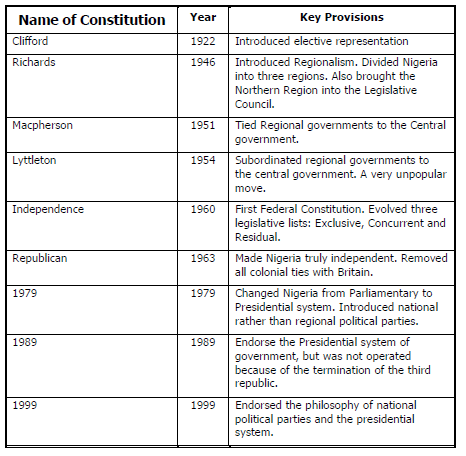Nigeria has a rich history of Constitutions. From 1922 – 1999 (both years inclusive) Nigeria had a total of nine Constitutions. These included the Clifford Constitution (1922), which introduced elective representation into legislative processes in Nigeria. The Richards Constitution of 1946 replaced the Clifford Constitution. This Constitution was significant for introducing regionalism into Nigeria, by dividing the country into three Regions. It was also significant because it brought the Northern Region into the Legislative Council. In a very strange sense, the Constitution introduced unity and disunity at the same time. The Richards Constitution created regional authorities, thus getting Nigerians to think along regional lines. However, real legislative power was still centralized, making unity possible.
The Macpherson Constitution (1951) replaced the Richards Constitution. The Macpherson Constitution was very
important because it was a result of wide consultations with the people of Nigeria, culminating in a Constituent Assembly convened at Ibadan, Oyo State in 1950. However, these consultations did not make it acceptable to Nigerians. The Regional Houses of Assembly were subordinated to the Legislative Council and the Central Executive, which effectively meant the Governor. The Macpherson Constitution broke down because it tied the regional governments to the Central Government. It was replaced by the first federal constitution, called the Lyttleton Constitution 1954. The Constitution evolved three categories of power and functions to be exercised in the federation viz:
(i) the Exclusive Legislative List, (ii) the Concurrent Legislative List, and (iii) the Residual powers.
The Exclusive Legislative List was assigned to the Federal Government. While the Concurrent List contained matters on which both the Federal and State Governments could legislate. The Constitution went further to set out ways of resolving conflicts that may arise in the process of exercising such functions and powers. On the other hand,
Residual powers were those not included in either the Exclusive or Concurrent Lists. The Regional Governments were empowered to make laws on residual powers.
The journey to Nigeria’s Independence continued between 1954 and 1960 with various constitutional conferences. The first was held in London in 1957 and the second in Lagos in 1958. The Eastern and Western Regions became self-governing in 1957. The Northern Region became self-governing in 1959. The Eastern Regional House of Chiefs was created in 1957. In 1958, the Minorities Commission of Enquiry, headed by Sir Henry Willink was setup. The
conference also approved a Second Chamber (i.e. the Senate) for the Federal Legislature. The Senate was made up of twelve members from each of the three regions; four members from the then Federal Territory of Lagos and four special members appointed by the Governor-General at his discretion. The Independence Constitution was drawn up with those additions to the 1954 Constitution. Each region was granted a separate Constitution different from that of the federation. The parliament of the federation was made up of the Governor-General, the Senate, and the House of Representatives.
In 1963, all colonial ties were removed by giving a Republican status to the country. The President replaced the Governor-General. However, Nigeria still remained a member of the British Commonwealth of Nations although appeals no longer went to the Privy Council. There was no other Constitution until 1979 because the Military overthrew the elected government on January 15, 1966. The 1979 Constitution introduced a system of national political parties as opposed to the regional parties of the past. The Constitution also changed Nigeria from a Parliamentary to a Presidential system of government. Unlike under the Parliamentary system, the President was elected by the whole country as his constituency to emphasize the need for unity. The Executive was also separated from the Legislature, which was not the case under the Parliamentary system. However, the Legislature served as a check on the Executive and must ratify all nominations for appointment by the Executive. The 1989 Constitution endorsed the same philosophy, but it did not fully come into operation because the Third Republic was never fully developed. The 1999 Constitution continued the philosophy of national political parties.

TABLE: NIGERIA’S CONSTITUTIONAL DEVELOPMENT (1922 – 1999)


